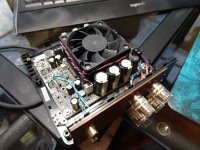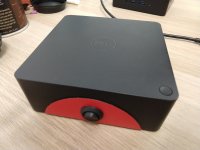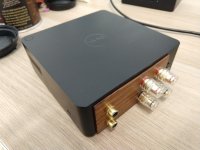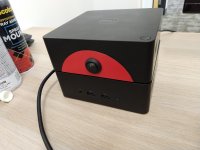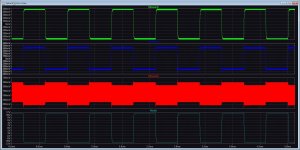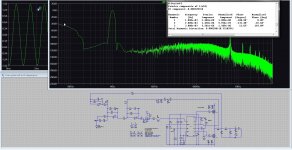Hi amigos,
Here my new Purifi DIY amp.
In a few words :
The Kayamb Audio Buffer is a DIY Buffer made by a friend of mine (thx to Teddy) and using :
The enclosure is a Galaxy GX alu case made in Italy and the Speakers terminals are in Copper. (Viborg style)
There is also a soft start module to limit destructive inrush currents
The amp is absolutely dead silent even with my ears glued to the speakers.
I also added a copper film on the Hypex transformer.
The default Buffer gain is -14DB, these buffers sound awesome by the way !
I am still testing the OPA1692 / 1656 and 1622. In progress....





Here my new Purifi DIY amp.
In a few words :
The Kayamb Audio Buffer is a DIY Buffer made by a friend of mine (thx to Teddy) and using :
- Susumu Japanese resistors
- Nichicon KZ Muse Audio grade caps
- DIP8 OP amps socket (OPA1656 here)
- Hypex HPR12 Voltage regulator
The enclosure is a Galaxy GX alu case made in Italy and the Speakers terminals are in Copper. (Viborg style)
There is also a soft start module to limit destructive inrush currents
The amp is absolutely dead silent even with my ears glued to the speakers.
I also added a copper film on the Hypex transformer.
The default Buffer gain is -14DB, these buffers sound awesome by the way !
I am still testing the OPA1692 / 1656 and 1622. In progress....





Hi,Hi amigos,
Here my new Purifi DIY amp.
In a few words :
The Kayamb Audio Buffer is a DIY Buffer made by a friend of mine (thx to Teddy) and using :
- Susumu Japanese resistors
- Nichicon KZ Muse Audio grade caps
- DIP8 OP amps socket (OPA1656 here)
- Hypex HPR12 Voltage regulator
The enclosure is a Galaxy GX alu case made in Italy and the Speakers terminals are in Copper. (Viborg style)
There is also a soft start module to limit destructive inrush currents
The amp is absolutely dead silent even with my ears glued to the speakers.
I also added a copper film on the Hypex transformer.
The default Buffer gain is -14DB, these buffers sound awesome by the way !
I am still testing the OPA1692 / 1656 and 1622. In progress....

How does that sound?
And compare to the new Topping PA5?
Hi,
How does that sound?
And compare to the new Topping PA5?
I can't tell vs the PA5.... not now.
But I can compare with my other Purifi with MS buffers (made in Italy). Both Purifi amps are very good and very close.
The Kayamb Buffers offer a very nice soundstage specially with the OPA1656. When I switched with the the OPA1622, the soundstage was not the same and less open. In addition, the OPA1622 strangely causes a slight pop when switching on.... The OPA1612 works fine too, very straight but not as good as the OPA1656.
For the moment, I continue to say that the best class D that I have remains the Satisfaction A2, the listening is as balanced and detailed as the Purifi but musically, the pleasure is much closer to an AB type amp, to my ears anyway.
There are two <opa 1612: one on buffer and one on vertical board in 1ET400A.
Do you change both or only on buffer ?
Is there an advantage to change both ?
Do you change both or only on buffer ?
Is there an advantage to change both ?
The 1ET400A. Purifi has no op amps. The op amps concern only the input buffers ) So you have one dual op amp per buffer.
The Eval board 1 and 2 are using opa1612 in soic8 format. (No updatable)
My favorite op amps are the 1692 and 1656. Both sound different but very well.
The Eval board 1 and 2 are using opa1612 in soic8 format. (No updatable)
My favorite op amps are the 1692 and 1656. Both sound different but very well.
Stuffed a Sure Wondom 2x100W T-amp into a Dell TB16 Docking station chassis......
...last picture is the unit on top of a functional docking station........for reference.
...last picture is the unit on top of a functional docking station........for reference.
Attachments
Man, that's cool! Well done 🙂 seems like there's heaps of cheap pc enclosures like this. How did you do the back panel?Stuffed a Sure Wondom 2x100W T-amp into a Dell TB16 Docking station chassis......
...last picture is the unit on top of a functional docking station........for reference.
Here's the basic rundown....
Lots of dremel tool grinding of plastic bosses and heat stakes......these have a 3 layer steel base inside to give the docking unit some "ballast" while sitting on your desk..really wanted to keep that but needed the headroom for the fan.......
The rear video, USB, network etc ports are covered by the thin tiger rosewood piece on the back..I had that as scrap.
The front USB ports and LED are covered by the red laminate (formica) semi-circle that I cut using a router with a circle template. I'm thinking about using more red formica scraps on the back instead of the rosewood......but I've got a TPA3255EVM and meanwell PS on the way so who knows.
I used double-sided tape to adhere the red laminate to the front..and the switch holds it on as well.
Lots of dremel tool grinding of plastic bosses and heat stakes......these have a 3 layer steel base inside to give the docking unit some "ballast" while sitting on your desk..really wanted to keep that but needed the headroom for the fan.......
The rear video, USB, network etc ports are covered by the thin tiger rosewood piece on the back..I had that as scrap.
The front USB ports and LED are covered by the red laminate (formica) semi-circle that I cut using a router with a circle template. I'm thinking about using more red formica scraps on the back instead of the rosewood......but I've got a TPA3255EVM and meanwell PS on the way so who knows.
I used double-sided tape to adhere the red laminate to the front..and the switch holds it on as well.
Thanks for sharing.Starkrimson Ultra Build.
First pic is in an old amp case. The other two are in the custom Modushop case.
New DIY Class-D amplifier. Not a Chinese chip-amp, but all DIY.
Fully balanced input stage.
Power: 2x400watt @ 4ohm
Output current capability = 40A
Gain: 33dB
THD: approx 0.001%
Phase shift less than 1 degree at 20kHz
Fully differential modulator
Input impedance: Single ended = 10kohm and Balanced = 20kohm
Output impedanse: Less than 1milliohm
Output Noise: Less than 30uV
Size: 91x100mm
Protetion circuit contains
Specs are fully comparable with the best on the market, like nCORE and Purifi, except for the totally flat phase curve. We have never seen any other class-D amp even close to this.

Fully balanced input stage.
Power: 2x400watt @ 4ohm
Output current capability = 40A
Gain: 33dB
THD: approx 0.001%
Phase shift less than 1 degree at 20kHz
Fully differential modulator
Input impedance: Single ended = 10kohm and Balanced = 20kohm
Output impedanse: Less than 1milliohm
Output Noise: Less than 30uV
Size: 91x100mm
Protetion circuit contains
- Fully differentiel DC-servo
- Thermal protection
- Short circuit protection (shut down @ 40A)
- Under/over voltage (bus pumping) shut down
- Auto Power down
Specs are fully comparable with the best on the market, like nCORE and Purifi, except for the totally flat phase curve. We have never seen any other class-D amp even close to this.
Last edited:
New DIY Class-D amplifier. Not a Chinese chip-amp, but all DIY.
Fully balanced input stage.
Power: 2x400watt @ 4ohm
Output current capability = 40A
Gain: 33dB
THD: approx 0.001%
Phase shift less than 1 degree at 20kHz
Fully differential modulator
Input impedance: Single ended = 10kohm and Balanced = 20kohm
Output impedanse: Less than 1milliohm
Output Noise: Less than 30uV
Size: 91x100mm
Protetion circuit contains
- Fully differentiel DC-servo
- Thermal protection
- Short circuit protection (shut down @ 40A)
- Under/over voltage (bus pumping) shut down
- Auto Power down
Specs are fully comparable with the best on the market, like nCORE and Purifi, except for the totally flat phase curve. We have never seen any other class-D amp even close to this.View attachment 1022572
Looks nice, its good to see a DIY project instead of plug and play amps were the only "DIY" thing seems to be opamp rolling.
I'm playing with something similar it's an all discrete design, except for the DC servo.
All the best
Stein
I really agree... This is turning into a "mechanical" forum, where users show their skills in mechanical assembly of chep low performance chinese amplifier modules. Nobody cares about audio performance. The thing that makes the readers go wild, is when the mechanical work looks nice. Beautiful looking chinese chip amps are the benchmark.Looks nice, its good to see a DIY project instead of plug and play amps were the only "DIY" thing seems to be opamp rolling.
I'm playing with something similar it's an all discrete design, except for the DC servo.
All the best
Stein
The PCB's for the final version is in production right now. So within 2 weeks they will be at my desk, ready for final testing on the Audio Precision, before sonic performence testing.Okay...virtual amp.....for now......😉😉😉
lovely build @Hurtig , which forum did you post the amps discussion, kindly shareNew DIY Class-D amplifier. Not a Chinese chip-amp, but all DIY.
Fully balanced input stage.
Power: 2x400watt @ 4ohm
Output current capability = 40A
Gain: 33dB
THD: approx 0.001%
Phase shift less than 1 degree at 20kHz
Fully differential modulator
Input impedance: Single ended = 10kohm and Balanced = 20kohm
Output impedanse: Less than 1milliohm
Output Noise: Less than 30uV
Size: 91x100mm
Protetion circuit contains
- Fully differentiel DC-servo
- Thermal protection
- Short circuit protection (shut down @ 40A)
- Under/over voltage (bus pumping) shut down
- Auto Power down
Specs are fully comparable with the best on the market, like nCORE and Purifi, except for the totally flat phase curve. We have never seen any other class-D amp even close to this.View attachment 1022572
This is the first time the amplifier has been released.lovely build @Hurtig , which forum did you post the amps discussion, kindly share
We are currently considering whether to start a small production of them. So if anyone is interested, please let me know 🤘
You say 0.001 distortion, with what power? because I do also work on c lass D, more from curiosity to learn some more about it. Did you use gan? I think not because of the big 40 amps output power. I have to say, you did a very good job making the pcb as it is. I see also much op amps, so I presume you did had the goal of a big gain to suppress distortions but do it then not get dull with sound.New DIY Class-D amplifier. Not a Chinese chip-amp, but all DIY.
Fully balanced input stage.
Power: 2x400watt @ 4ohm
Output current capability = 40A
Gain: 33dB
THD: approx 0.001%
Phase shift less than 1 degree at 20kHz
Fully differential modulator
Input impedance: Single ended = 10kohm and Balanced = 20kohm
Output impedanse: Less than 1milliohm
Output Noise: Less than 30uV
Size: 91x100mm
Protetion circuit contains
- Fully differentiel DC-servo
- Thermal protection
- Short circuit protection (shut down @ 40A)
- Under/over voltage (bus pumping) shut down
- Auto Power down
Specs are fully comparable with the best on the market, like nCORE and Purifi, except for the totally flat phase curve. We have never seen any other class-D amp even close to this.View attachment 1022572
Here I have simulate a version as a test, taking idea from papers on the internet. I did see when do this design, or others, is that getting a nice square, I sit quite on the right track, do I get a very low distortions like the other pic, the square get messed up, unstable, so there is a sweet spot in feedback systems class d.
I wish you luck with this beautifully looking amplifier, if it sounds as it looks, then in Dutch, zit je gebeiteld.
greetings.
Attachments
We have not used GAL outputs, but traditional MOSFET, as it has not been necessary to obtain results.You say 0.001 distortion, with what power? because I do also work on c lass D, more from curiosity to learn some more about it. Did you use gan? I think not because of the big 40 amps output power. I have to say, you did a very good job making the pcb as it is. I see also much op amps, so I presume you did had the goal of a big gain to suppress distortions but do it then not get dull with sound.
Here I have simulate a version as a test, taking idea from papers on the internet. I did see when do this design, or others, is that getting a nice square, I sit quite on the right track, do I get a very low distortions like the other pic, the square get messed up, unstable, so there is a sweet spot in feedback systems class d.
I wish you luck with this beautifully looking amplifier, if it sounds as it looks, then in Dutch, zit je gebeiteld.
greetings.
In general, the output transistors have only a limited influence on the final result.
If you want to achieve good results, then it must be achieved in the design of the modulator and the feedback loop. You will see ex ICEPower, nCORE and Purifi, which without aggregation are the class-D amplifiers with the best performance. And there are simple designs, such as application note designs are limited.
We use a fully differential 5th order modulator, and a double feedback loop where one loop operates inside the other. Gain in the loop is mathematically optimized, to achieve the lowest possible distortion and no phase shift.
Is the amplifier single supply rail?This is the first time the amplifier has been released.
We are currently considering whether to start a small production of them. So if anyone is interested, please let me know 🤘
- Home
- Amplifiers
- Class D
- Class D Amp Photo Gallery
